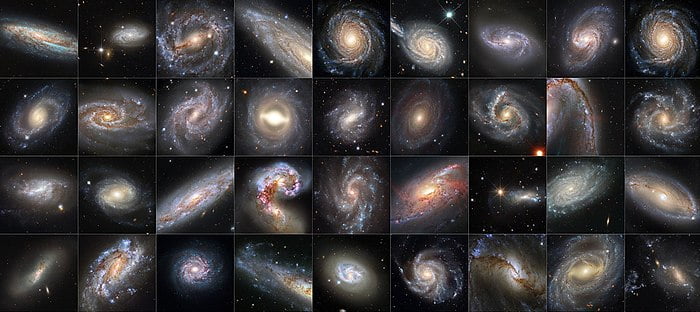- Get link
- X
- Other Apps

How Many Galaxies Are There in Space?
It is estimated that there are roughly 200 billion galaxies (2×1011) in the observable universe. Most galaxies are 1,000 to 100,000 parsecs in diameter (approximately 3,000 to 300,000 light years) and are separated by distances on the order of millions of parsecs (or megaparsecs).
Introduction:
The vastness of space never fails to amaze us, with its countless stars, nebulae, and other cosmic wonders. Among these celestial structures, galaxies stand out as majestic and awe-inspiring entities. In this blog post, we will embark on a journey through the cosmos to explore the intriguing question: How many galaxies are there in space? Join us as we delve into the mind-boggling scale of the universe and the vast number of galaxies it encompasses.
What is a Galaxy?
Before we delve into the numbers, let’s first understand what a galaxy is. A galaxy is a vast collection of stars, stellar remnants, gas, dust, and dark matter bound together by gravity. These cosmic structures come in various shapes and sizes, ranging from small dwarf galaxies to massive elliptical and spiral galaxies. Our own Milky Way galaxy is just one of the billions of galaxies in the universe.
Galaxy Classification:
Astronomers classify galaxies into different types based on their shape and structure. The main categories are:
- Spiral Galaxies: These galaxies have a characteristic spiral structure, with arms winding outward from a central nucleus. Our Milky Way is a prime example of a spiral galaxy.
- Elliptical Galaxies: Elliptical galaxies have a smooth, ellipsoidal shape and lack the prominent spiral arms. They range from nearly spherical to highly elongated shapes.
- Irregular Galaxies: Irregular galaxies have no well-defined structure and exhibit a more chaotic appearance. They often result from gravitational interactions or mergers between galaxies.
The Observable Universe:
The observable universe is the portion of the universe that we can potentially observe from Earth. It is limited by the distance light has traveled since the Big Bang, which defines the observable horizon. Within this vast expanse, astronomers have attempted to estimate the number of galaxies.
Estimates and Surprising Discoveries:
Based on observations from various ground-based and space telescopes, including the Hubble Space Telescope, scientists have made remarkable strides in estimating the number of galaxies in the observable universe. Current estimates suggest that there could be anywhere between 100 billion to 200 billion galaxies. However, it’s important to note that these are rough estimates, and the actual number may be even higher.
Furthermore, recent studies have unveiled that the number of galaxies in the universe may be much larger than previously thought. The discoveries of small and ultra-faint galaxies that were previously undetectable have contributed to this new understanding. These findings hint at the presence of countless dwarf galaxies and suggest that the actual number of galaxies in the universe could be in the trillions.
The Unfathomable Scale of the Universe:
Considering the estimated number of galaxies, each containing billions to trillions of stars, the sheer magnitude of the cosmos is truly mind-boggling. The vastness of space becomes even more awe-inspiring when we consider that each of these galaxies represents a unique cosmic tapestry, with its own stellar populations, nebulae, and potential planetary systems.
Beyond the Observable Universe:
It’s important to acknowledge that the observable universe represents only a fraction of the entire cosmos. The universe is believed to be much larger and may extend far beyond what we can currently observe. As our technology advances and we develop more powerful telescopes and observational techniques, our understanding of the universe’s size and the number of galaxies within it will continue to evolve.
Conclusion:
While the exact number of galaxies in space remains an ongoing subject of scientific exploration and refinement, current estimates suggest a staggering figure of billions to possibly trillions of galaxies within the observable universe. Each of these galaxies holds the potential for countless wonders and cosmic marvels, leaving us in perpetual awe of the grandeur and complexity of the universe.
So, the next time you
gaze at the starry night sky, remember that you are glimpsing just a tiny fraction of the majestic galaxies that populate the cosmos, inviting us to explore, contemplate, and marvel at the mysteries that lie beyond.
- Get link
- X
- Other Apps
Comments
Post a Comment